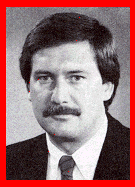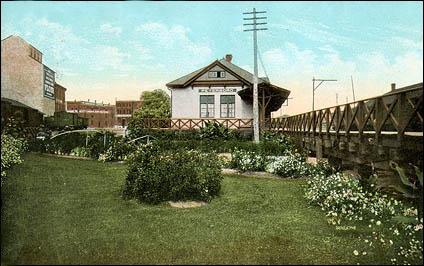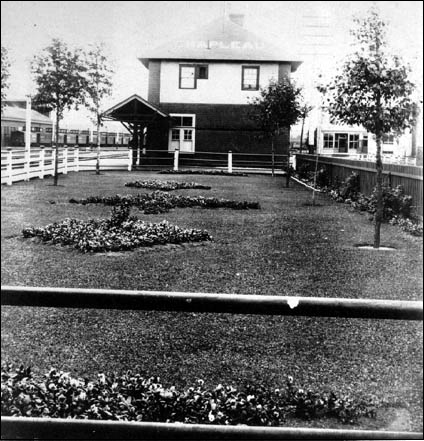Vol. 18 No. 5
May, 1988
|
Make Tomorrow Happen
|

Garden Program
Spruces Up
the Stations
|

Dave Jones
|

Peterborough Ontario - Date/photographer unknown.
In the initial rush to build stations across the country when new railway
lines were under construction, little thought was given to the aesthetic appeal, or lack thereof, of the grounds
immediately surrounding these structures.
Worse yet, the station yards sometimes took on the appearance of local dumps what with piles of engine cinders,
coal, discarded cans, bottles, crates, and barrels - even the occasional abandoned wagon or automobile lying around.
Of course, many of the station agents and section foremen took it upon themselves to keep their yards neat, and,
with the addition of a little judicious landscaping and a few shrubs and flowers thrown in for good measure, some
became quite attractive.
By 1908, the CPR realized the need to introduce a comprehensive program to supply all of the company's stations with
seeds, bulbs, and most importantly supervision, to create gardens which would be eye pleasers for the railway's
patrons and also a source of produce for the agents' families.
The "Johnny Appleseed" Role
A specialist with a degree in horticulture, Gustaf A. Bosson Krook, was hired by the Department of Natural Resources
to spearhead the project. Soon he was criss-crossing the country, travelling some 60,000 kilometres a
year in his "Johnny Appleseed" role.
Virtually hundreds of gardens were established under Mr. Krook's guidance, and many thousands of indigenous flowers,
shrubs, and trees were planted, supplemented by occasional imports such as California poppies, Norway Spruce, and
Russian Poplar.
Trees, being both attractive landscaping items and useful windbreaks, were particularly in demand. To aid in their
acquisition, a company nursery was operated in Wolseley, Saskatchewan, between 1912 and 1923. Tens of thousands of
Caragana and Tamarak trees were grown and distributed from this centre.
Advice on layouts and aesthetics was also freely given: "It is bad taste to cut up the lawn with paths,
too many flower beds, or specimen trees", cautioned one notice penned by Mr. Krook. "Unless there is an
absolute need for a path, leave it out".
Nevertheless, a lot of leeway was left for individual creativity and no two gardens looked the same. While many were
content with a tasteful, subdued display, others strove to create the unusual. Sometimes the community name was
spelled out in flowers or in whitewashed rocks. At Broadview, Saskatchewan, the word "produce" was written
in vegetables, while Appin, Ontario, featured a Union Jack made entirely of flowers.
Perhaps the most talked about display was the garden at Harvey, New Brunswick, where the shrubs were clipped into
the shape of a man, his dog, and two deer.
Vegetables Given Additional Attention
Vegetables were given additional attention during both World Wars. The garden at Coldwater, Ontario, for example,
could turn out 20 bags of potatoes and 60 baskets of tomatoes on an annual basis. More than a few salads were tossed
from the wide variety of vegetables grown at Coldwater.
The Department of Natural Resources managed to recruit a number of highly qualified men. A successor to Mr. Krook,
John R. Almey served as the CPR's general agricultural agent until his retirement in 1960. Seven years later, he was
rewarded for this lifetime of commitment to horticulture development by having a tree that had been named for him
the Almey Crab, chosen as the country's "centennial tree". Because of its ability to thrive in every
province from coast to coast, it was an appropriate selection.
From 1961, Lulu Island near Vancouver became the centre for flower production under the watchful eye of chief
horticulturist, A.C. Thistle. Seven large greenhouses turned out an annual 45,000 bulbs, 5,000 potted plants, and
100,000 bedding plants. To fill the beds in front of the Chateau Lake Louise, 15,000 Icelandic poppies were
cultivated, while 5,000 geraniums were set aside for the public rooms of the Banff Springs Hotel.
Regional Green-Thumbed Producers
A number of regional green-thumbed producers also were employed. Frank Atfield, for one, operated a
greenhouse at Glen Yard in Montreal. The 22 varieties of plants he grew were distributed as far east as Woodstock,
New Brunswick, and as far west as London, Ontario.
The elaborate garden at Montreal West, alone, required 6,000 plants yearly. Additional blooms ended up in the
staterooms of the company's Great Lakes steamships.
Although the company's local gardening efforts were greatly admired, and are remembered fondly by those who
travelled the company lines, an equally-special horticultural shipment travelled out of the country
each December for many years.
From the 1930s, coniferous trees loaded on flatcars were shipped to the United States. By the mid-1950s,
800 boxcars, loaded with 2,200 trees per car, headed south to bring Christmas trees to the people of Georgia,
Louisiana, Texas, and California. Too large a task for the floral committee of the Department of Natural Resources,
but no problem for the Forestry Branch.

Chapleau Ontario - 1920 photographer unknown.
This CP Rail News article is copyright
1988 by the Canadian Pacific Railway and is reprinted here with
their permission. All photographs, logos, and trademarks are the property of the Canadian Pacific Railway
Company.
|